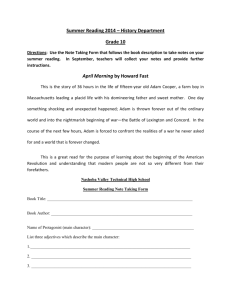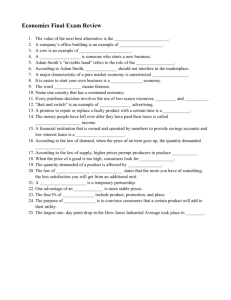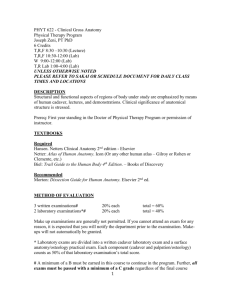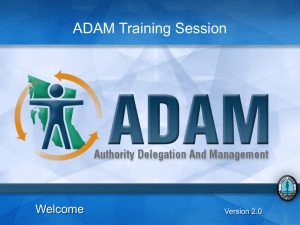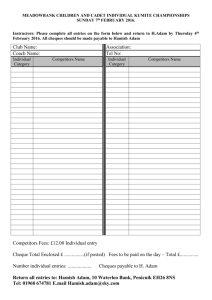1 Course: Anatomy and Physiology (Biology 202 Lab) Instructor: Dr
advertisement
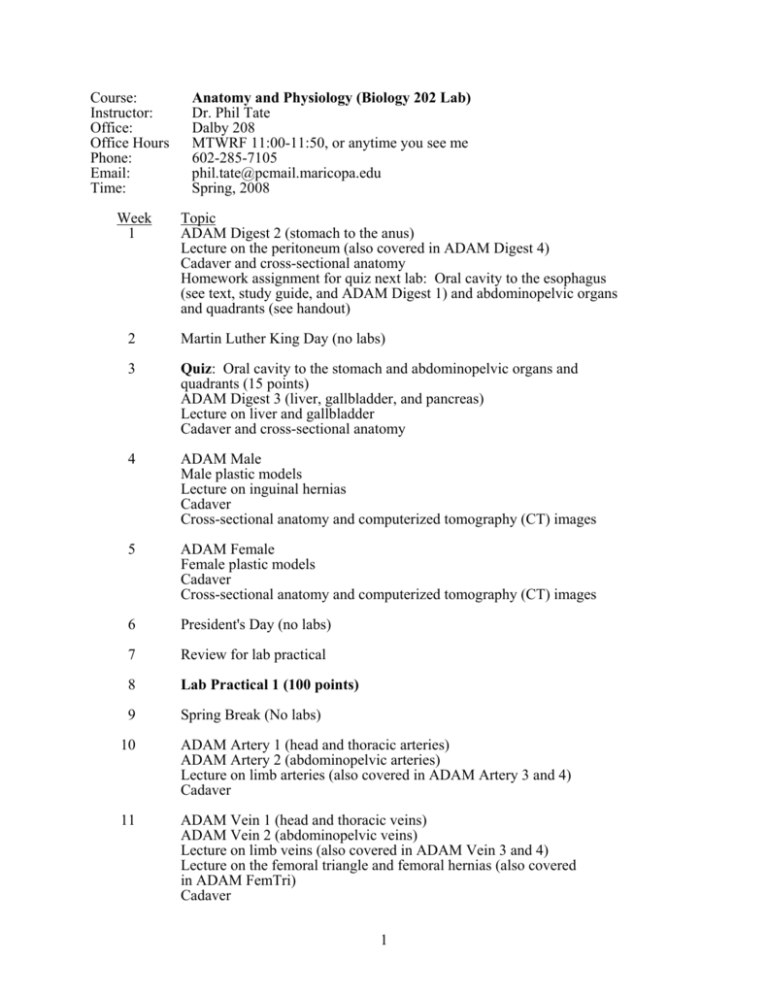
Course: Instructor: Office: Office Hours Phone: Email: Time: Week 1 Anatomy and Physiology (Biology 202 Lab) Dr. Phil Tate Dalby 208 MTWRF 11:00-11:50, or anytime you see me 602-285-7105 phil.tate@pcmail.maricopa.edu Spring, 2008 Topic ADAM Digest 2 (stomach to the anus) Lecture on the peritoneum (also covered in ADAM Digest 4) Cadaver and cross-sectional anatomy Homework assignment for quiz next lab: Oral cavity to the esophagus (see text, study guide, and ADAM Digest 1) and abdominopelvic organs and quadrants (see handout) 2 Martin Luther King Day (no labs) 3 Quiz: Oral cavity to the stomach and abdominopelvic organs and quadrants (15 points) ADAM Digest 3 (liver, gallbladder, and pancreas) Lecture on liver and gallbladder Cadaver and cross-sectional anatomy 4 ADAM Male Male plastic models Lecture on inguinal hernias Cadaver Cross-sectional anatomy and computerized tomography (CT) images 5 ADAM Female Female plastic models Cadaver Cross-sectional anatomy and computerized tomography (CT) images 6 President's Day (no labs) 7 Review for lab practical 8 Lab Practical 1 (100 points) 9 Spring Break (No labs) 10 ADAM Artery 1 (head and thoracic arteries) ADAM Artery 2 (abdominopelvic arteries) Lecture on limb arteries (also covered in ADAM Artery 3 and 4) Cadaver 11 ADAM Vein 1 (head and thoracic veins) ADAM Vein 2 (abdominopelvic veins) Lecture on limb veins (also covered in ADAM Vein 3 and 4) Lecture on the femoral triangle and femoral hernias (also covered in ADAM FemTri) Cadaver 1 12 Lecture on heart anatomy Sheep heart dissection 13 Lecture on the electrocardiogram and blood pressure Making electrocardiograms and taking blood pressures Review for lab practical 14 Lab Practical 2 (100 points) Homework assignment for quiz next lab: Upper respiratory tract (see text, study guide, and ADAM Respir 1) 15 Quiz: Upper respiratory tract (15 points) ADAM Respir 2 (lower respiratory tract) ADAM Urinary 1 (gross anatomy of the urinary system) Cadaver and cross-sectional anatomy Lung volumes 16 Lecture on kidney internal anatomy (also covered in ADAM Urinary 2) Regulation of the urinary bladder (paper and pencil exercise; 10 points) Acid-base balance (paper and pencil exercise; 10 points) Review for lab practical 17 Lab Practical 3 (50 points) - Finals Week Monday lab - Monday, May 5, 1-2:50 p.m. Tuesday lab – Tuesday, May 6, 2-3:50 p.m. Wednesday lab – Wednesday, May 7, 12-1:50 p.m. Friday lab - Wednesday, May 7, 2-3:50 p.m. The above schedule is tentative and may be changed if necessary. Cadaver Program 1. The anatomy and physiology program at Phoenix College uses cadaver demonstrations and animal organ dissections as part of the laboratory experience. 2. These activities are a required part of the course. If you feel that you might have difficulties with this aspect of the class, please talk with me immediately (that means today). It may be necessary to enroll you in a different course. Lab Materials 1. For the first lab, you will be provided with lab notes. After that, you will need to print your own notes. It is possible to print the notes at the library, but you will have to pay for copying. 2. Go to http://www.pc.maricopa.edu/biology/files/tate/biology202/ to get the notes. Practical 1 2 3 Folder Lab Practical 1 Lab Practical 2 Lab Practical 3 3. To read these files, you will need Adobe (Acrobat) Reader. Most computers have Adobe Reader. Get a free download at http://www.adobe.com/products/acrobat/readstep2.html 2 Point Distribution: 1. There are 300 points possible. Assignment Lab practical 1 Lab practical 2 Lab practical 3 Quiz oral cavity and esophagus Quiz upper respiratory tract Regulation of the urinary bladder Acid-base balance Total Points 100 100 50 15 15 10 10 300 2. The lab practicals will be short answer questions. Grades: 1. The grade for the lab is determined by adding together all individual scores and calculating one final percent score. 90% 80% 70% 60% 0% - 100% = A - 89% = B - 79% = C - 69% = D - 59% = F 2. The lab instructor will report your lab scores to the lecture instructor, who will determine the final course grade. Makeup Lab Practical: 1. Lab practical dates are listed on page 1 of this syllabus. It is possible that exam dates may change. If that happens, the new exam dates will be announced in class. It is your responsibility to know when exams are scheduled. 2. Missing a lab practical is highly discouraged. If you must miss the lab practical on the day of your scheduled lab, certain alternative test times may be arranged ahead of time. 3. Under exceptional circumstances, a makeup lab practical may be given during final exams week. Policies: 1. You are allowed one unexcused laboratory absence. 2. Tardiness is rude and disruptive. Being on time, ready to learn makes common sense and is common courtesy. Excess absences or tardiness will result in your withdrawal from the course. 3. See the Student Handbook for a detailed description of all policies. 3 Withdrawal: 1. The last day a student can initiate withdrawal from the course without an instructor's signature is Friday, February 29th. The student must file an official "withdrawal" form with the Admissions Office. 2. The last day a student can withdraw, with an instructor's signature, is Monday, April 21st. 3. Do not just stop attending class and expect your instructor to withdraw you from class. If you wish to withdraw, begin the process by notifying your instructor. 4. If you do not officially withdraw, your grade for all work completed and uncompleted can become part of your record. Textbook Anatomy and Physiology (8th ed.) by Seeley, Stephens, and Tate. It is highly recommended that you bring the textbook to lab because it has many useful illustrations. Study Guide Study Guide to Accompany Anatomy and Physiology (8th ed.) by Tate, Kennedy, and Seeley. The study guide has useful diagrams that can be labeled for review. Lab Practical Study Guide 1 Chapter 24 (pp. 369, 379, and 386) Chapter 28 (pp. 427, 443, and 445) 2 Chapter 20 (p. 293) Chapter 21 (pp. 309-315) 3 Chapter 23 (pp. 346, 347, and 349) Chapter 26 (pp. 411 and 413) Web Sites For Anatomy and Physiology http://www.mhhe.com/seeley7 Use this link to get the Cross-Sectional Miniatlas. Open the Web site and then click on the Student Edition in the lower left hand corner. Click on Course Tools for the Cross-Sectional Miniatlas, which can be downloaded. Student Services 1. The Disability Support Services (DSS) Office coordinates services which will ensure equal access to college programs for students with disabilities. Services include interpreting for the deaf/hard of hearing, note taking, reading, scribing, adaptive technology, testing accommodations, alternative text formatting, and special seating arrangements. Some classroom accommodations such as interpreting services, audio taped texts and handouts, enlarged print and brailled materials require preparation time. 4 2. Students with disabilities are encouraged to contact the DSS Office prior to registration and provide us with the necessary documentation. All disability-related information provided to DSS remains confidential. The DDS office is located in the Learning Center Building (Telephone: (602) 285-7477 V/TDD) Math and Science Center 1. The Math and Science Center is located on the second floor of the library. 2. ADAM and free tutoring are available at the Math and Science Center. 3. Math and Science Center hours: Monday - Thursday 8:00 a.m. - 7:00 p.m. Friday 8:00 a.m. – 2:00 p.m. Saturday 9:00 a.m. – 1:00 p.m. 5

